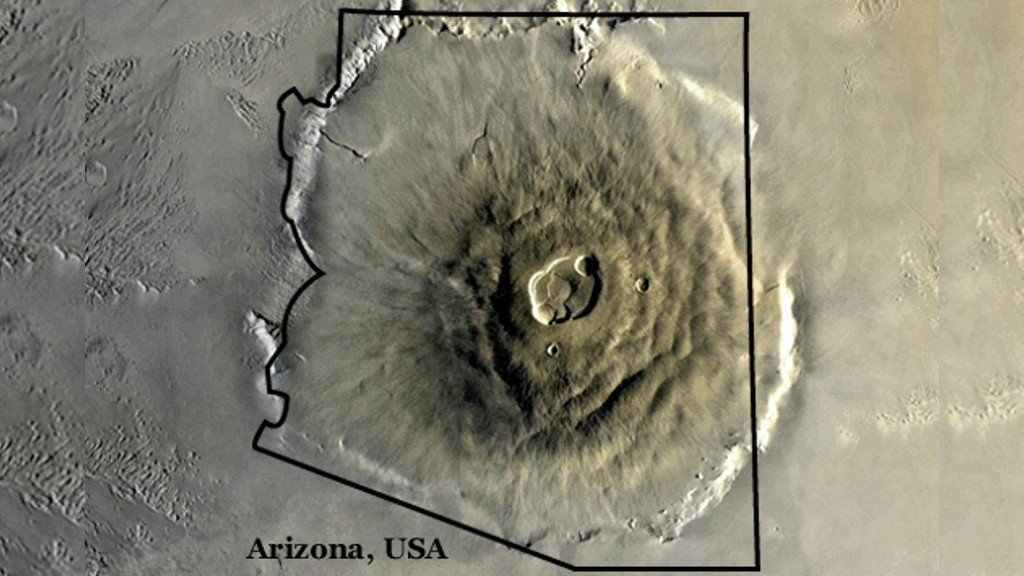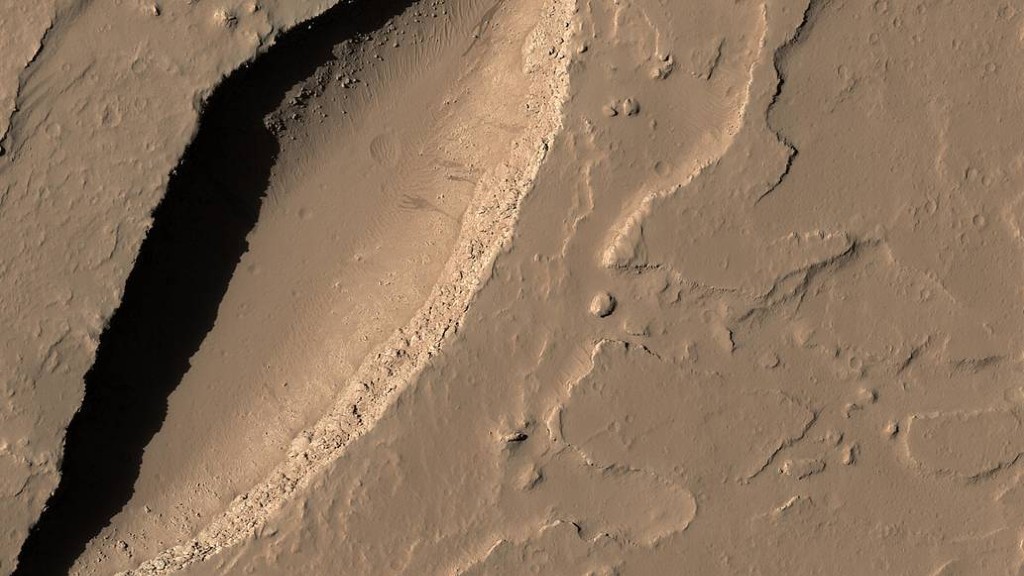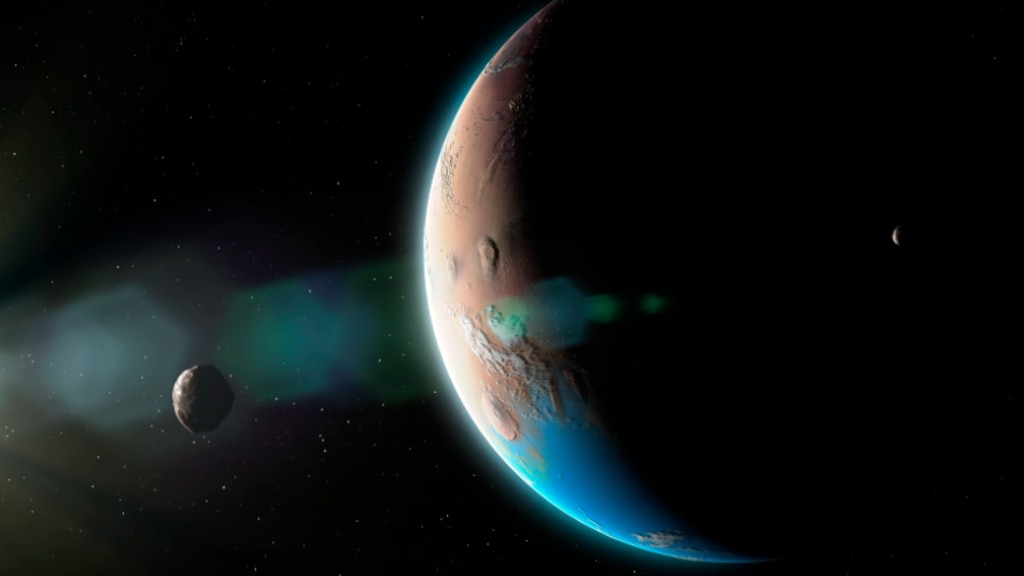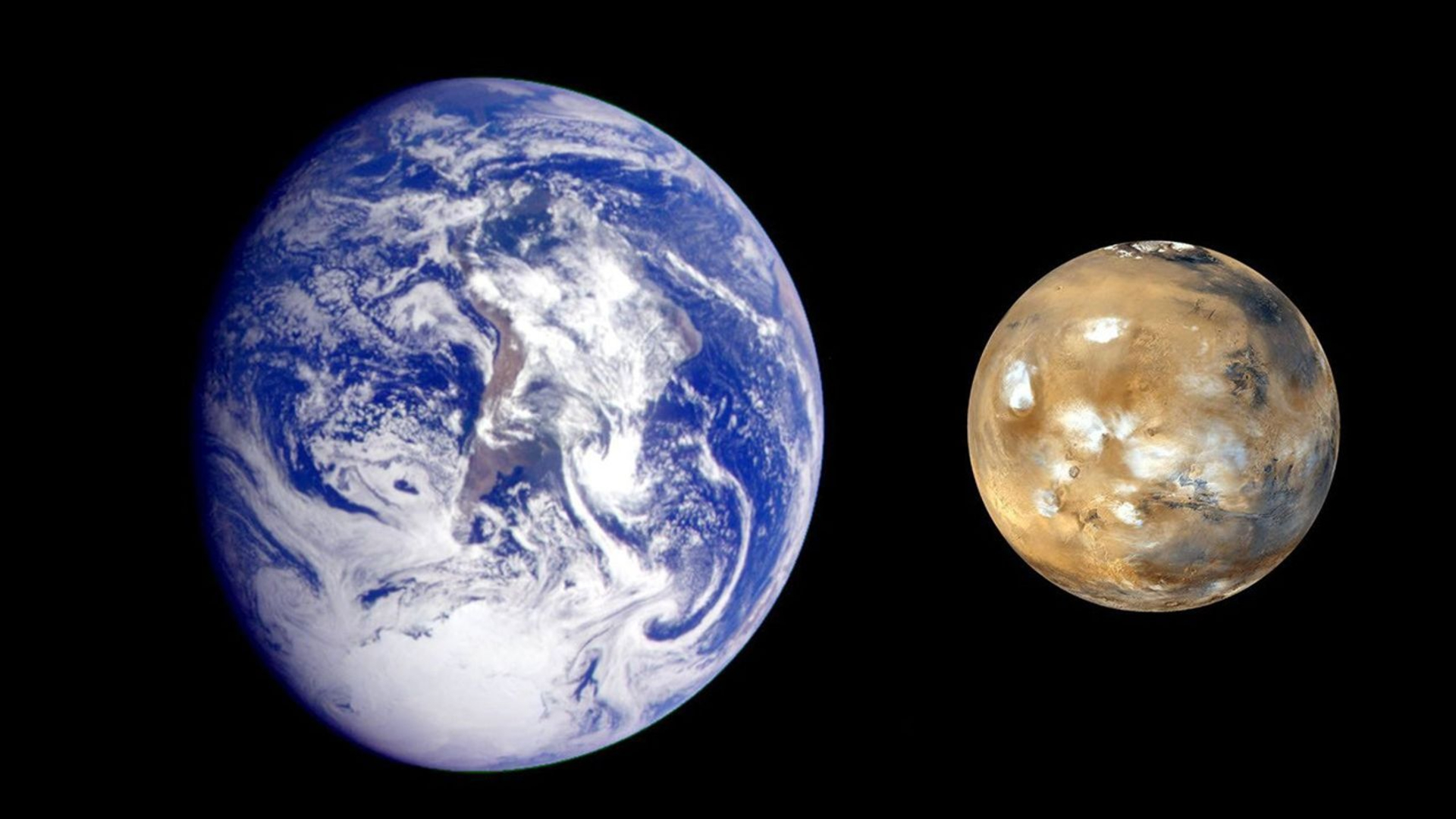Olympus Mons: The largest volcano in the solar system
Olympus Mons is a giant volcano on Mars, three times as high as Everest and as wide as France.

Mars' Olympus Mons is the largest volcano in the solar system. The massive Martian mountain towers high above the surrounding plains of the red planet, and may be biding its time until the next eruption.
Found in the Tharsis Montes region near the Martian equator, Olympus Mons is one of a dozen large volcanoes, many of which are ten to a hundred times taller than their terrestrial counterparts. Olympus Mons is the tallest of them all towers 16 miles (25 kilometers) above the surrounding plains and stretches across 374 miles (601 km) — roughly the size of the state of Arizona.
In comparison, Hawaii's Mauna Loa, the tallest volcano on Earth, rises 6.3 miles (10 km) above the sea floor (but its peak is only 2.6 miles above sea level). The volume contained by Olympus Mons is about a hundred times that of Mauna Loa, and the entire Hawaiian island chain (from Kauai to Hawaii) that houses it could fit inside its Martian counterpart.
Related: 10 incredible volcanoes in our solar system
Since there's no surface water on Mars, it isn't as easy to quantify terrain heights there as it is on Earth. But scientists have defined an effective 'sea level' for Mars, known as the areoid, which is an imaginary sphere having the average equatorial radius of the planet. This turns out to be quite a bit higher than the plain surrounding Olympus Mons, and relative to the areoid the mountain is only 13 miles (21 km) high — but that's still a record-breaking size.
Even so, the fact that it’s so broad means that it doesn’t look like a typical mountain on Earth. If you were standing on it, it would simply appear to be a gently sloping plain.
Size, shape and age
Height: 16 miles (25 km)
Diameter: 374 miles (601 km)
Volcano type: Shield
Olympus Mons rises three times higher than Earth's highest mountain, Mount Everest, whose peak is 5.5 miles (8.8 km) above sea level.
Breaking space news, the latest updates on rocket launches, skywatching events and more!
Olympus Mons is a shield volcano. Rather than violently spewing molten material, shield volcanoes are created by lava slowly flowing down their sides. As a result, the mountain has a low, squat appearance, with an average slope of only 5 percent.
When compared to Martian terrain in general, there aren't many impact craters on Olympus Mons' surface. This indicates that the uppermost layer of lava is relatively young, with the last eruption occurring as recently as 25 million years ago. This raises the intriguing possibility that the volcano is still active, and may erupt again in the future.
Related: Origins, variants and eruptions of space volcanoes
Six collapsed craters, known as calderas, stack on top of one another to create a depression at the summit that is 53 miles wide (85 km). As magma chambers beneath the calderas emptied of lava, most likely during an eruption, the chambers collapsed, no longer able to support the weight of the ground above.
A cliff, or escarpment, surrounds the outer edge of the volcano, reaching as high as 6 miles (10 km) above the surrounding area. (The cliff alone is about as tall as Mauna Loa.) A wide depression surrounds the base of the volcano as its immense weight presses into the crust.
Olympus Mons is still a relatively young volcano. Although it has taken billions of years to form, some regions of the mountain may be only a few million years old, relatively young in the lifetime of the solar system. As such, Olympus Mons may still be an active volcano with the potential to erupt.
"On Earth, the Hawaiian islands were built from volcanoes that erupted as the Earth's crust slid over a hot spot — a plume of rising magma," said Jacob Bleacher, a planetary scientist at Arizona State University and NASA's Goddard Space Flight Center in Greenbelt, Md, told Space.com. "Our research raises the possibility that the opposite happens on Mars; a plume might move beneath the stationary crust."
The tallest volcano in the solar system may also house rock glaciers — rocky debris frozen in ice. Snow and ice deposits above the base of the shield could result in such glaciers. Water-ice insulated by surface dust may exist near the top of the volcano. The tops of these glaciers may host ridges, furrows, and lobes, and be covered by rocks and boulders, and could be as young as four million years old.
How did Olympus Mons form?
Why would such a huge volcano form on Mars but not on Earth?
Scientists think that the lower surface gravity of the red planet, combined with higher eruption rates, allowed for the lava on Mars to pile up higher.
The presence and absence of tectonic plates could also play an important role in the different kinds of volcanoes. The hot spots of lava under the crust remain in the same location on both planets. On Earth, however, the movement of the crust prevents the steady buildup of lava. The Hawaiian Islands, for instance, formed as a plate drifted over a hot spot. Each eruption created a small island in a different spot.
But Mars has very limited plate movement. Both the hot spot and the crust remain unmoving. When lava flows to the surface, it continues to pile up in a single spot. Instead of a chain of volcanic islands, large volcanoes such as Olympus Mons form. In fact, three other large volcanoes near Olympus Mons are similarly gigantic; if only one of the four volcanoes in the region existed, it would be the tallest feature in the solar system.
In addition to the lack of plate movement, the growth of Olympus Mons was aided by its extended lifetime. While we don't have any rovers exploring the mountains right now, planetary scientists manage to probe the volcanoes with rocks from Earth. By studying six nakhlite meteorites from Mars previously established as volcanic, scientists confirmed the extensive lifetime of Martian volcanoes.
We found that the nakhlites formed from at least four eruptions over the course of 90 million years," Benjamin Cohen, a planetary scientist at the University of Glasgow in Scotland, said in a statement. "This is a very long time for a volcano, and much longer than the duration of terrestrial volcanoes, which are typically only active for a few million years."
The meteorites were blown into space when a massive rock crashed into the planet 11 million years ago.
"And this is only scratching the surface of the volcano, as only a very small amount of rock would have been ejected by the impact crater — so the volcano must have been active for much longer," Cohen said.
Another group of 11 Martian meteorites revealed that the volcanoes were active even longer. While 10 were only 500 million years old, an 11th, NWA 7635, was found to be 2.4 billion years old.
"What this means is that for 2 billion years there's been sort of a steady plume of magma in one location on the surface of Mars," researcher Marc Caffee, a professor of physics and astronomy at Purdue University in Indiana, said in a statement. "We don't have anything like that on Earth, where something is that stable for 2 billion years at a specific location."
Exploring Martian volcanoes
The volcanoes in Tharsis Montes are so large that they tower above the seasonal Martian dust storms. Italian astronomer Giovanni Schiaparelli, who studied the Martian surface intensively in the late 19th century, observed the enormous features from Earth using an 8-inch (22-centimeter) telescope. When NASA's Mariner 9 arrived at the red planet in 1971, it was able to pick out the tops of the volcanoes above the storms.
The high altitude of Olympus Mons makes a parachute-assisted descent difficult in the tenuous atmosphere, while the presence of loose dust would cause maneuvering problems for rovers. Even so, if Martian space tourism gets going in the coming decades, Olympus Mons could become a prime target for adventurous holiday-makers. In 2021, a group of students from the Royal Institute of Technology in Stockholm, Sweden, put together a proposal for a mission they believed might be feasible by 2042. A rover would take a group of three people close to the summit of the giant volcano, and then two of them would complete the final section on foot.
Alternatively, a company called 4th Planet Logistics, which describes itself as "founded for the purpose of designing, building, and evaluating human habitat structures and related support components for utilization on the moon, Mars, and beyond," is looking to create a virtual-reality climbing route for the enormous mountain.
"I'd like to extend a personal invitation to become involved in our effort to establish a climbing route to the summit of Olympus Mons," 4th Planet Logistics founder and director Michael Chalmer Dunn said in a post on the company's blog.
This means that while you can't physically climb the massive volcano, you may be able to at least explore it visually. Some scientists have used the High Resolution Stereo Camera installed on the European Mars Express orbiter to create a mosaic and terrain model of the volcano.
Additional resources
You can explore some of the imagery taken of Olympus Mons by visiting NASA's Mars Exploration Program page. Additionally, see the mountain's caldera close-up on ESA's website.
Bibliography
"Mount Olympus Mons Ascension Mission Overall Coordination - Team Red". Royal Institute of Technology (2021).
"Highest and Lowest Points on Mars" Geology.com. Hobart M. King, PhD, RPG
"Olympus Mons (20°N,135°W)". Olympus Mons (20°N,135°W).
"Olympus Mons: The Biggest Hotspot in the Solar System". Lowell Observatory (2020).
"New Research Uncovers 90 Million Years of History of Martian Volcano". University of Glasgow (2017).
"Monster Martian volcano unlike anything on Earth, scientists say". Purdue University (2017).
"Mystery Solved Regarding Largest Volcano in the Solar SystemScientists at the Institute of Geological Sciences at Freie Universität Berlin Succeeded in Simulating the Evolution of the Mars Volcano Olympus Mons". Freie Universität Berlin (2016).

Nola Taylor Tillman is a contributing writer for Space.com. She loves all things space and astronomy-related, and always wants to learn more. She has a Bachelor's degree in English and Astrophysics from Agnes Scott College and served as an intern at Sky & Telescope magazine. She loves to speak to groups on astronomy-related subjects. She lives with her husband in Atlanta, Georgia. Follow her on Bluesky at @astrowriter.social.bluesky
- Andrew MayAstrophysicist



